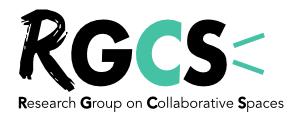By Heloise Berkowitz (Ecole Polytechnique, i3-CRG)
We thank IBEI for graciously hosting the event and for Carlos, Helena and Gloria for their precious help in organizing the seminar. And we thank our three presentators : Ignasi Capdevila (PSB), Tomas Diez (Fab City Research Lab Director, Smart Citizen Co-founder) and Sergi Figueres Moret (former IBEI student, co-founder and CEO of “Worldcoo”).
***********
On the 25th of May, Institut Barcelona d’Estudis Internacionals hosted a #RGCSBarcelona seminar on “Collaborative finance for collaborative spaces”. The objective was to open a dialogue between two dimensions of the collaborative economy: fab labs and crowdfunding. Indeed, the collaborative economy not only deeply transforms and challenges working practices, but also calls for rethinking funding models and financial systems.

A demonstration of percussions opened the seminar, right below the windows of the classroom.
******** First presentation ********
The seminar started with a presentation by Ignasi Capdevila, associate professor at PSB Paris School of Business on “Coworking Spaces: A multi-level view of localized dynamics of innovation. The case of Barcelona”.
Coworking spaces, hacker spaces, fab labs, innovation labs, many different terms describe this phenomenon of collaborative spaces. And Barcelona is one of the cities with the highest density of coworking spaces. Yet, the definition of what is a coworking space remains relatively unclear. MOB Makers of Barcelona for instance is an informal place: a third space, not home, not an office. People are there to work but also to have fun, be creative. In Betahaus Barcelona, it is not just a shared office, more things that happen there.
Much of academic research is focused on creativity, innovation dynamics. Creativity is not so much of a lonely process, inventing things in your garage, while being cut from the rest of the world. On the contrary, people innovate well in a social environment. The second important thing is that you can start innovation dynamics outside of big corporations.
A typology of open collaborative spaces can be based on the innovation approach (exploration vs exploitation), and governance type (bottom up vs top-down)[1].

For instance, a hacker space has a bottom up approach, it flourishes easily. Let’s hack for the pleasure of hacking. But in coworking spaces, they are all entrepreneurs, they all want to monetize what they do.
Coworking space appears as an alternative to two main traditional options. In general, workers are forced to choose between working at home for themselves or working at an office for a company.
Coworking spaces transform work practices at three different levels.
First at the level of internal innovation dynamics: what happens in these spaces? Not all coworking spaces are the same.
In some of them, classified as cost related, collaboration happens because actors reduce their costs. There is no selection of membership at all in this kind of coworking space. And it is not really a business model. Then there are resource-based collaborations, that provide coaching, share knowledge, etc. and they tend to specialize. And finally, in relational collaboration co-working spaces, even more things happen, like empowering the community, transmitting an inspiring vision. Community becomes more independent. Actors create their own space in this third kind of space.
At another level, the one of local innovation dynamics, the question is: how do the other actors around the space relate to these spaces? The degree of openness changes a lot. There is an interplay of different dynamics of innovation: the physical place (if it’s good, well located, people can go and meet), space (cognitive space, a specialty or dedication around one topic), events and projects (both are temporary bounded).

A lot of different people meet in events and projects but it is bounded in time. All these dimensions help be in contact with the city, and the density of this makes the city more innovative.
The third and last level is the one of global innovation dynamics inter-cities. There are dynamics inside coworking spaces, inside cities but also across cities. Local coworking spaces are often organized into European networks, which facilitate transfer knowledge between cities and fab labs. If you can codify something in a book, a book is easy to pass on. But knowledge is hard to pass on.
“I cannot teach you how to ride a bike on the phone. But if we are in New York and Barcelona, and we have both the same bike and a conference call device, maybe I can teach you”. Linkages between Betahaus Berlin and Betahaus Barcelona for instance allow this kind of knowledge transfers.
This raises many questions, especially regarding public policy and public funding. What is more convenient at the European level? Is it not better to invest into this kind of bottom up private spaces?
******** Second presentation ********
The next presentation was from Tomas Diez, Fab City Research Lab Director, Smart Citizen Co-founder. He is Venezuelan and started the first fab lab in the European Union. It is a collective project based on the observation that technology has been dramatically reshaping cities, just like industrialization used to mass produces how we live.

We fly things around the world, the objective is to produce profit no matter what. The digitalization centralizes ownership of capital around information, and computation. Smart city model is a way to have control of over city and individuals. I would rather speak of smart citizens to empower them.
“Cities have the capability of providing something for everybody, only because, and only when, they are created by everybody.”
― Jane Jacobs, The Death and Life of Great American Cities
Technological empowerment can lead to keeping the same market logics. It results in a monocultivation of money. Yet new technology offers the means to empower us, from being consumers of information we are now becoming producers of information. New technology is also enabling people to organize themselves to become empowered.
We are in the third digital revolution: fablabs are extending, generalizing access to machines which you can use to produce anything, 3d printers for instance. Fablabs are being used not to replicate the world as we know it, but to create new tools. Fablabs are producing fablabs. I can send things in 2 secs across the world to produce things.
Fablab academy is distributed education where you can learn to make anything. In the bio academy for instance, we can study learn that future of fabrication is growing things, we are getting a future where we will be able to let material grow itself. We will not make things we will grow them. You will no longer go buy your mobile phone, you will grow them. We will become farmers again.

There are different models today, linear vs circular models. In his book “Design for the Real World: Human Ecology and Social Change”, Victor Papanek explains that industrial design is one of the most dangerous activity in the world.
We are definitely challenging that. The product is never finished. It is context at work. Product is not IP produced. But it raises questions. If I grow my own meat in my house, what are the regulatory implications.
We are currently mapping poblenou fab city prototype. The idea is to identify the potential of the city without re-inventing the wheel. There are already actors, players that are there, who can provide the opportunities. We are trying to rescale globalization. Our cities currently have low resilience, we have to change that.
Different mayors pushing the fab city challenge, Barcelona, Boston, Amsterdam, Paris…. Detroit, Bhutan… etc. Today it’s 12 cities, 2 regions, 2 countries, trying to use the fablab philosophy and trying to scale it up to cities. We are trying to move from a linear to a spiral production ecosystem following the DIDO, data in, data out, model.
We are launching many different initiatives, like Fablabs.io, which is open source, using github, etc. We are trying to make a market, a model in which every part of the chain gets some part of the value generated. We are thinking of using the blockchain technology. We want to move from PITO (product in trash out) to DIDO (data in data out)
Nasa just launched a competition to develop a space fablab manufactory. You need to have the tools to produce locally.
******** Third presentation ********
The final presentation was made by Sergi Figueres Moret, former IBEI student, co-founder and CEO of “Worldcoo”, an e-commerce solution for donation to high social impact projects.

Worldcoo is an online tool for funding social projects. The idea is when you buy something online, or pay for something, you can also donate 1, 2, 10 euros to an NGO or charity project. It’s therefore different from the majority of current crowdfunding platforms. We solve problems for ecommerce, NGO, and consumers.
When we started, we found out we were actually competing with charity and NGOs for the same funding sources (corporates, firms, city council, generalitat…). So we understood we needed to start finding new ways of funding their projects. Today we, as a society, penalize companies that have no CSR principles, so it’s important for them to develop CSR projects.
How we do it: we create a widget that links ecommerce with social impact project. We integrate the widget in the ecommerce platforms to offer clients the possibility of making a donation to specific social projects.
Here, in Spain it’s hard regarding legal statuses, we had the same issues as Tomas.
We have some investors. We make money. We do not charge the charities and NGOs for the funds, but we charge them for provision of services, after we have directly given them the funds they have collected. We charge them 8% for services.
We are focusing on Spain, UK, Italy… We have funded projects in more than 40 companies. We are a team of 14, in Barcelona, with free-lancers in Madrid and Paris where we are trying to grow and find more companies.
We have strategic partners such Unicef, Banco Sabadell, IngenioGroup, eTail, AbTasty. We are growing between 100% and 300% a year.
We work with many companies from e-commerce and banks. Now we are developing a physical payment terminal: when you pay with your credit card in a physical shop, you can be offered “round up to 19.50 to 20 euros and donate to fight cancer”.
We also have corporate pages, for Telefonica or IBEI for instance. IBEI is launching a crowdfunding initiative to fund the scholarship of a student from Sub-Saharan regions[2].
We are not sustainable yet, like many start-ups. We are a BtoB, we look for companies, we do not do marketing strategies. Also, we won a h2020 funding, more than 1 million last year. Now we can go in any country in Europe.
We want to become the worldwide leader of tech donation. There is almost no competitor. All NGOs that did this now use us. There are some local initiatives, but they do not want to grow as we do.
***********
[1] See Capdevila, I., 2016, Une typologie d’espaces ouverts d’innovation basée sur les différents modes d’innovation et motivations à la participation, Gestion 2000, 33 (4), 93-116, accessible on : https://www.researchgate.net/publication/313789873_Une_typologie_d’espaces_ouverts_d’innovation_basee_sur_les_differents_modes_d’innovation_et_motivations_a_la_participation
[2] http://www.ibei.org/es/help-crowdfund-the-alumni-scholarship-for-a-student-from-a-sub-saharan-university_65211
